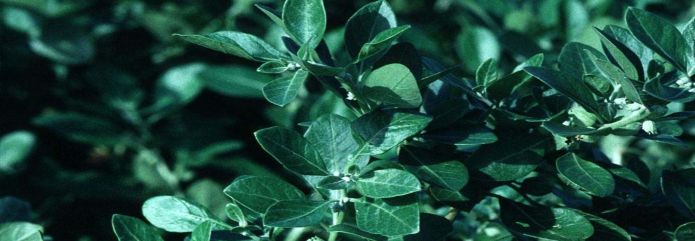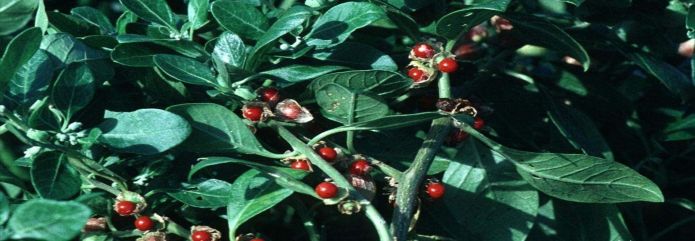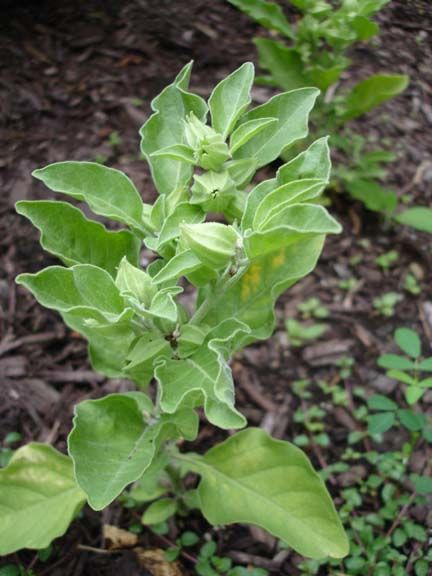Jupiterpharma.in

International Journal of PharmTech Research
CODEN (USA): IJPRIF ISSN : 0974-4304
Vol. 3, No.1, pp 187-192, Jan-Mar 2011
Withania somnifera: A Rejuvenating
Ayurvedic Medicinal Herb for the Treatment
of various Human ailments
Veena Sharma*, Sadhana Sharma, Pracheta, Ritu Paliwal
Department of Bioscience and Biotechnology, Banasthali University,
Banasthali-304022, Rajasthan, India
*Corres.author: [email protected], Tel.: + 01438228386
Abstract: India is one of the 12 mega-diversity countries. It is estimated that around 70,000 plant species,
approximately 7500 species have been recorded to have medicinal value. The 300 species are used by 7800 medicinal
drug manufacturing units in India, which consume about 2000 tons of herbs annually. There are estimated to be more
than 717,319 registered practitioners of ayurveda, siddha, unani and homeopathy in India and in recent years, the
growing demand for herbal products has led to the extinction of many important plant herbs. Ashwagandha is also a rare
and endangered plant. Withania somnifera possess good immunomodulatory anti-inflammatory, anti-tumor, antioxidant,
anticancer properties and many pharmacologically and medicinally important chemicals, they protect the cells from
oxidative damage and diseases. In present paper we have tried to unveil the therapeutic knowledge about Ashwagandha,
which is used to exploit novel medicines. Considering its relevance, further research is required to explore the potential
from this medicinal herb.
Keywords: Withania somnifera; immunomodulatory; anti-inflammatory; antioxidant; Withaferin A; alkaloids.
INTRODUCTION
According to the World health organization, traditional
created huge issues related to the potency and quality
medicines are widely used in India. Approximately
of medicinal products derived from these plants.
80% of the population of developing countries rely on
Withania somnifera (Family: Solanaceae) is a popular
traditional medicines for their primary health care
Indian medicinal plant and is also known as
needs 1-3. Medicinal plants continue to play a central
ashwagandha, ginseng, and winter cherry. It has been
role in the health care system of large proportions of
an important herb in the ayurvedic and indigenous
the world's populations. Recognition and development
medical system for over 3000 years. Numerous studies
of the medicinal and economic benefits of these plants
indicated that ashwagandha possesses antioxidant,
are on the increase in both developing and
antitumor, antistress, anti-inflammatory, immuno-
industrialised nations. The medicinal plants contain
modulatory, hematopoetic, anti-ageing, anxiolytic, ant-
several phytochemicals such as Vitamins (A, C, E, and
depressive rejuvenating properties and also influences
K), Carotenoids, Terpenoids, Flavonoids, Polyphenols,
various neurotransmitter receptors in the central
Alkaloids, Tannins, Saponins, Enzymes, and Minerals
nervous system 4. In recent studies done on human
etc. These phytochemicals possess antioxidant
breast, lung and colon cancer cell lines, plant extracts
activities, which can be used in the treatment of
inhibited the growth of these cell lines. The researchers
multiple ailments. Most often the medicinal plants are
revealed that a specific extract from the plant,
collected from the wild. This uncontrolled harvesting
Withaferin A, was more effective in the inhibition than
has resulted in the extinction of many plants and
the common cancer chemotherapy drug, doxorubicin,




Veena Sharma et al /Int.J. PharmTech Res.2011,3(1)
they used to compare it with 5. Studies revealed that
conditions, increasing the capability of the individual
the anti-inflammatory and immunomodulatory
to resist adverse environmental factors and creating a
properties of Withania somnifera (WS) root extracts
sense of mental wellbeing 7. It is in use for a very long
are likely to contribute to the chemo preventive action
time for all groups and both sexes and even during
6. The roots of the plant are categorised as rasayanas,
pregnancy without any side effects 8.
which are reputed to promote health and longevity by
In this review, we have attempted to summarize briefly
augmenting defence against disease, arresting the
the information available on the potency of WS
ageing process, revitalising the body in debilitated
because of its immense therapeutic potential.
Figure1: W. Somnifera in its fruiting stage
Figure 2: Withania somnifera
Figure 3: Roots of Withania Somnifera
Veena Sharma et al /Int.J. PharmTech Res.2011,3(1)
BOTANY AND DISTRIBUTION
It improves learning ability and memory capacity. The
Withania somnifera is a small, erect, evergreen woody
traditional use of ‘Ashwagandha' was to increase
under shrub belongs to Solanaceae family that grows
energy, youthful vigour, endurance, strength, health,
or reaches about 30-150cm in height. Withania
nurture the time elements of the body, increase vital
somnifera is known by various vernacular names i.e.
fluids, muscle fat, blood, lymph, semen and cell
In Hindi it is known as Asgandh; in English, Winter
production. It also helps to counteract chronic fatigue,
cherry; in Turangi, Gandha; in Bengali, Aswagandha;
weakness, dehydration, bone weakness, loose teeth,
in Gujarati, Ghodakun & Ghoda; in Telgu, Vajigandha
thirst, impotency, premature aging emaciation,
& Pulivendram, in Tamil, Amukkira; in Karnataka,
debility, convalescence and muscle tension. It helps to
Viremaddlinagadde; in Goa, Fatarfoda; in Punjabi,
invigorate the body by rejuvenating the reproductive
Asgand; in Malyalam, Amukkuram; in Kannada,
organs, just as a tree is invigorated by feeding the roots
Viremaddinagaddi; in Bombay, Asgund; in
12-15. Fruits, leaves and seeds of this plant have been
traditionally used for the Ayurvedic system as
This plant grows wildly in all drier parts of subtropical
aphrodisiacs, diuretics and for treating memory loss.
India i.e. in Madhya Pradesh, Uttar Pradesh, Punjab
The Japanese patent applications are related to the use
plains and North-western parts of India like Gujarat
of the herb as a skin ointment and for promoting
and Rajasthan. It is also found in Congo, South Africa,
reproductive fertility. In US, the New England
Egypt, Morocco, Jordan, Pakistan and Afganistan 9.
Deaconess Hospital, has taken a patent on an
The fleshy roots when dry are cylindrical, gradually
Ashwagandha formulation claimed to alleviate
tapering down with a brownish white surface and pure
symptoms associated with arthritis 16. The product
white inside when broken. The roots are the main
called "ashwagandha oil" is a combination of
portions of the plant that are widely used as therapeutic
ashwagandha with almond oil and rose water designed
agents. Leaves are simple, ovate, glabrous, 10 cm long,
to be used as a facial toner. Two acyl steryl
dense beneath and sparse above. Flowers
glucosides, sitoindoside VII and sitoindoside VIII
inconspicuous, greenish or lubrid-yellow, in axillary,
isolated from the roots of Withania somnifera were
umbellate cymes; berries small, globose, orange-red
screened for putative antistress activity using a diverse
when mature, enclosed in the persistent calyx; seed
spectrum of stressinduced paradigms. Two new
yellow, reniform. The bright red fruit is harvested in
Glycowithanolides, Sitoindoside IX (1) and
the late fall and seeds are dried for planting in the
Sitoindoside X (2) isolated from Withania somnifera
following spring.
were evaluated for their immunomodulatory and CNSeffects (anti-stress, memory and learning) (3) It is said
to have free radical scavenger activity (antioxidant
In Ayurveda, Ashwagandha is considered as a
activity) in In vivo model where it has increased
rasayana herb, which works on a nonspecific basis to
superoxide dismutase and catalase activities of rat liver
increase health and longevity. W. somnifera has been
16. The active principles of Withania somnifera
in use for over 2500 years to treat all kind of diseases
consisting of equimolar amounts of Sitoindosides
and human ailments 10. This herb is also considered as
VIIX and Withaferin A were investigated for putative
an adaptogen which is a nontoxic herb that works on a
nootropic activity in a experimentally validated
nonspecific basis to normalize physiological function,
Alzheimer's disease model. The syndrome was
working on the HPA axis and the neuro-endocrine
induced by ibotenic acid (IA) lesioning of the nucleus
system. The roots and berries of the plant are used in
basalis magnocellularis in rats. Withania somnifera
herbal medicine. In Ayurveda, the fresh roots are
significantly reversed both IA induced cognitive
sometimes boiled in milk, prior to drying, in order to
deficit and the reduction in cholenergic markers after 2
leach out undesirable constituents. The berries are
weeks of treatment. These findings validate the
used as a substitute for rennet, to coagulate milk in
Medharasayan (promoter of learning and memory)
cheese making 11. The species name somnifera means
effect of Withania somnifera as has been reported in
"sleep-bearing" in Latin, indicating it was considered a
Ayurveda 17. Studies of ashwagandha showed that an
sedative, but it has been also used for sexual vitality
acetone extract of alkaloids caused mild CNS
and as an adaptogen.
depression in dogs and mice and protected against
In the traditional system of medicine Ayurveda, this
supramaximal electroshock seizures in rats. The
plant is claimed to have potent aphrodisiac
extract caused hypothermia in mice and potentiated
rejuvenative and life prolonging properties. It has
hypnosis induced by barbiturates, ethanol and urethane
general animating and regenerative qualities and is
used among others for the treatment of nervous
Root of Withania somnifera used for the treatment of
exhaustion, memory related conditions, insomnia,
asthma, bronchitis, edema, leucoderma, anorexia,
tiredness potency issues, skin problems and coughing.
consumption, asthenia, anemia, exhaustion, aging,
Veena Sharma et al /Int.J. PharmTech Res.2011,3(1)
insomnia, ADD/ADHD, neurasthenia, infertility,
constituents like withaniol, acylsteryl glucosides,
impotence, repeated miscarriage, paralysis, memory
starch, reducing sugar,
loss, multiple sclerosis, immune- dysfunction,
hantreacotane, ducitol, a variety of amino acid
carcinoma, rheumatism, arthritis, lumbago 19-23. Leaves
including aspartic acid, proline, tyrosine, alanine,
have been used internally for fever and haemorrhoids;
glycine, glutamic acid, cystine, tryptophan, and high
externally for wounds, haemorrhoids, tumours,
amount of iron.
tuberculosis glands, anthrax pustules, syphilitic sores,
Withania somnifera has chemo genetic variation and
erysipelas, and in ophthalmitis 22,23. Fruits are used
so far three chemotype I, II and III had been reported
externally in ringworm 22.
37. In Indian variety thirteen Dragendroff positive
A methanolic & 80% ethanolic extract of Withania
alkaloids have been obtained.
somnifera displayed significant anti-inflammatory
The reported alkaloids are anaferine [bis (2-
activity on carrageenan- induced paw edema 24. The
piperidylmethyl) ketone]; isopelletierine; tropine;
root extract of Ashwagandha prevented the rise of
experimentally induced LPO in rabbits & mice 25.
cuscohygrine; dl-isopelletierine; anahygrine; hygrine;
Withaferin A and Sitoindosider VIII-X exhibits fairly
mesoanaferine; choline; somniferine; withanine;
potent anti- arthritic, anti- inflammatory, antioxidant &
withananine; hentriacontane; visamine;withasomine, a
immuno modulant activities, they also increase in the
pyrazole derivative from west Germany;
levels of SOD, CAT, GPX in brain & the steroidal
pseudowithanine and ashwagandhine.Withaniol
lactone W.A 26. Withaferin A, also showed significant
(mixture of withanolides) and number of withanolides
antitumor & radiosensitizing effects in experimental
including withaferine-A; withanolide N and O;
tumors without any toxicity & inhibiting tumor growth
withanolide D; withanolide p and 8; withanolide Q and
increasing survival in swiss albino mice inoculated
R; withanolide y, 14α- hydroxyl steroids and
with Ehrlich ascites (ESC) carcinoma 27-29.
withanolides G, H, I, J, K and U 38.Seven new
The administration of Ashwagandha Rasayana
withanolide glycosides called withanosides I, II, III ,
significantly reduced the lung tumor nodule formation
IV, V, VI and VII had been isolated and identified 39.
and also reduced leucopenia induced by cyclo-
Much of Ws pharmacological activity has been
phosphamide treated experimental animals, indicating
attributed to two main withanolides, withaferin A and
its usefulness in cancer therapy 30, 31. Withania increase
withanolide D.
the WBC count, reduce leucopenia. They alsoincreased bone marrow cellularity &normalised theratio of hormachromatic erythrocytes & polychromatic
erythrocytes 31.
Medicinal plants maintain the health & vitality ofindividuals & also cure disease, without causing
toxicity. As Withania somnifera possess good
The plant is chemically very complex and more than
immunomodulatory anti-inflammatory, antitumor,
80 compounds are known from it 32. The biologically
antioxidant, anticancer properties and many
active chemical constituents are alkaloids
pharmacologically and medicinally important
(ashwagandhine, cuscohygrine, anahygrine, tropine
chemicals, such as Withaferins, sitoindosides and
etc), steroidal compounds, including ergostane type
various alkaloids, they protect the cells from oxidative
steroidallactones, withaferin A, withanolides A-
damage and diseases. Thus consume a good diet, rich
in antioxidant plant foods (eg. Fruits and vegetables)
withasomniferolsA-C, withsomniferin A,
will provide health- protective effects. In conclusion,
withasomnidienone, withasomniferols A-C, withanone
this article provides the therapeutic knowledge about
etc. The constituents of Withania roots are the
Withania somnifera, which is used by the people all
steroidal alkaloids and steroidal lactones. They belong
over the world. Also, it is of significance to exploit
to a class of constituents called the withanolides 33, 34,
novel medicines from Withania somnifera. Although,
with the main active chemical constituent Withaferin
the results from this review are quite promising for the
A, a phytosteroid 35. Other constituents include
use of this plant as a multi-purpose medicinal agent.
saponins containing an additional acyl group(sitoindoside VII and VIII), and withanoloides with a
glucose at carben 27 (sitoindoside ix and x) 33, 36. Apart
The authors are thankful to the authorities of
from these contents plant also contain chemical
Banasthali University for providing support to thestudy.
Veena Sharma et al /Int.J. PharmTech Res.2011,3(1)
powder in mice"; Ind. J. Physiol. Pharmacol.
1.Allison P. Global survey of marine and estuarine
1997; 41(4): 424-426.
species used for traditional medicine and tonic
17. Bhattacharya SK, Kumar A and Ghosal S.
foods. WHO Report, McGill University,
"Effects of Glycowithanolides form Withania
Quebee, Canada. 1966.
somnifera on an animal model of Alzheimer's
2. Anonymous. Medicinal plants: Their
Disease and perturbed Central Cholinergic
Biodiversity, Screening and Evaluation. Center
Markers of Cognition in rats"; Phytotherapy
for Science and Technology of the Non- aligned
Research. 1994; 8: 1-4.
and other developing countries, New Delhi.
18. Malhotra CL, Mehta VL, Das PK and Dhalla
NS. "Studies on Withania ashwagandha kaul
3. Bhattacharjee SK. Handbook of medicinal
(Part-V): The effect of total alkaloids
plants. Pointer publishers, Jaipur, India. 1998.
(ashwagandholine) on the CNS, Ind. J. Physiol.
4. Pattipati S, Amanpreet S, Shrinivas K. Effect of
Pharmacol. 1965; 127-136.
Withania somnifera root extract on Haloperidol
19. Nadkarni and Dr. KM. The Indian Materia
induced Orofacial Dyskinesia: Possible
Medica, with Ayurvedic, Unani and Home
mechanism of action. J. Med. Food 2003; 6(2):
Remedies. Revised and enlarged by A.K. 1976.
20. Frawley, David and Vasant Lad. The yoga of
5. Jayaprakasam B, Zhang Y, Seeram N and Nair
Herbs: An Ayurvedic Guide to Herbal Medicine.
M. Growth inhibition of human tumour cell lines
Santa Fe: Lotus Press. 1986.
by withanolides from Withania somnifera
21. Dash and Bhagwan. Materia Medica of
leaves. Life Sciences. 2003; 74: 125-132.
Ayurneda. New Delhi: B.Jain Publishers. 1991.
6. Prakash J, Gupta S and Dinda A. Withania
22. Kirtikar KR and Basu BD Indian Medicinal
somnifera root extract prevents DMBA-induced
plants. 2nd ed. Vol.1-4. 1935. Reprint. Delhi:
squamous cell carcinoma of skin in Swiss albino
Periodical Experts. 1993.
mice. Nutrition cancer. 2002; 1: 91-97
23. Varrier. Mention that a paste made of the roots
7. Weiner MA and Weiner J. Ashwagandha (India
and bruised leaves may be applied to carbuncles,
ginseng). In: Herbs that. Quantum Book, Mill
ulcers and painful swellings. 1996; p. 409.
Valley, CA. 1994; 70-72.
24. Hindawi -al MKIH, AI-Deen, Nabi MH and
8. Sharma S, Dahanukar and Karandikar SM.
Ismail MH. Anti-inflammatory activity of some
Effects of long-term administration of the roots
Iraqi plants using intact rats. Journal
of ashwagandha and shatavari in rats. Indian
Ethnopharmacol. 1989; 26 (2): 1638.
Drugs. 1985; 29:133-139.
25. Dhuley JN. Therapeutic efficacy of
9. Kokate CK, Purohit AP and Gokhale SB.
Ashwagandha against experimental aspergillosis
"Pharmacognosy", 4th edition, 624-629, Nirali
in mice. Immuopharmacol Immunotoxicol.
Prakashan, Pune. 1996.
1998; 20 (1): 191-8.
10. Bhattacharya A, Ghosal S and Bhattacharya S.
26. Bhattacharya SK, Satyan KS and Ghosal S.
Antioxidant effect of WS glycowithanolides in
Antioxidant activity of glycowithanolides from
chronic foot shock induced perturbations of
Withania somnifera. Indian J Exp Biol. 1997; 35
oxidative free radical scavenging enzymes and
lipid peroxidation in rat frontal cortex and
27. Devi PU, Sharada AC and Solomon FE. In vivo
striatum. Journal Ethnopharmacol. 2001; 74: 1-
growth inhibitory and radiosensitizing
effects of withaferin A on mouse Ehrlich ascites
11. Puri HS. RASAYANA: Ayurvedic Herbs of
carcinoma. Cancer Lett. 1995; 16(1-2): 189-93.
Rejuvenation and Longevity. Taylor & Francis,
28. Devi PU.
Withania somnifera Dunal
London. 2003; p. 46-58.
(Ashwagandha): potential plant source of a
12. Nadakarni. Indian Materia Medica. 1993; 1:
promising drug for cancer chemotherapy and
radiosensitization. Indian Journal Exp Biol.
13. Vaidyaratnam PS Varier's. Indian Medicinal
1996; 34 (10): 927-32.
Plants, a compendium of 500 species". 1994.
29. Sharad AC, Solomon FE, Devi PU, Udupa N
14. Sharma PV (1997) Dravyaguna Vigyan,
and Srinivasan KK. Antitumor and
Chowkambha Sanskrit Sansthan.
radiosenitizing effects of withaferin A on mouse
15. Charaka Samhita and Chikitsa Sthana. Second
Ehrlich ascites carcinoma in vivo. Acta Oncol.
Chapter, Chowkambha Publishers, 38
1996; 35(1): 95-100.
30. Menon LG, Kuttan R and Kuttan G. Effect of
16. Panda S and Kar A. "Evidence for free radical
rasayanas in the inhibition of lung metastasis
scavenging activity of Ashwagandha root
Veena Sharma et al /Int.J. PharmTech Res.2011,3(1)
induced by B16F-10 melanoma cells: Journal
Withaferin A, Journal Chem Soc. 1965; 30:
Exp Clinical Cancer Res. 1997; 16(4): 365-8.
31. Davis L and Kuttan G. Suppressive effect of
36. Ganzera MI, Chodhary IA and Khan.
cyclo-phosphamide-induced toxicity by
Quantitaive HPLC analysis of withanolides in
Withania somnifera extract in mice. J
Withania somnifera. Fitoerapia. 2003; 74 (1-2):
Ethnopharmacol. 1998; 62 (3): 209-14
32. Van Wyk B, Oudtshoorn BV and Gericke N.
37. Abraham A, Kirson I, Glotter E and Lavie D. A
Medicinal plants of South Africa: Briza
chemotaxonomical study of Withania somnifera
publications. 2000; p. 274.
(L) Dunal. Phytochem. 1968; 7: 957-962.
33. Elsakka M, Grigoreseu E, Stanescu U and
38. Kirson and Glotter E. 14α-hydroxy steroids from
Dorneanu V. New data referring to chemistry of
Withania somnifera (L) Dunal. Journal
Withania somnifera species, Rev Med Chir Soc
Chemistry Research Synop, 1980; 10:338-339.
Med Nat lasi. 1990; 94: 358-387.
39. Matsuda H, Murakami T, Kishi A and
34. Mishra L, Singh B and Dagenais S. Scientific
Yoshikawa M. Structures of withanosides I, II,
basis for therapeutic use of Withania somnifera
III, IV, V, VI and VII new withanolide
(Ashwagandha): A review, Alternative medicine
glycosides from the roots of Indian Withania
Reviews. 2000; 5: 335-346.
somnifera D and inhibitory activity for
35. Lavi D, Glotter E, Shro Y. Constituents of
tachyphylaxis to clonidine in isolated guineapig
Withania somnifera Dun, The structure of
ileum. Bioorg. Med. Chemistry. 2001; 96: 1499-1507.
Source: http://jupiterpharma.in/journalpdf/Ashwagandha%20as%20a%20Rejuvinating%20Ayrvedic%20herb.pdf
Bey-OTC-copy_Layout 1 11-03-24 2:12 PM Page 1 What are over-the-counter drugs? BEYOND BASIC Over-the-counter drugs are medications sold directly to consumers through pharmacies, grocery andconvenience stores without a prescription. The availability of remedies is as ubiquitous as the conditions for which consumers may seek assistance and are offered in the form of pharmaceutically producedand naturally occurring (herbal) products.
Published Ahead of Print on March 8, 2010 as 10.1200/JCO.2009.24.4798 JOURNAL OF CLINICAL ONCOLOGY Prediction of Risk of Distant Recurrence Using the 21-GeneRecurrence Score in Node-Negative and Node-PositivePostmenopausal Patients With Breast Cancer Treated WithAnastrozole or Tamoxifen: A TransATAC StudyMitch Dowsett, Jack Cuzick, Christopher Wale, John Forbes, Elizabeth A. Mallon, Janine Salter, Emma Quinn,Anita Dunbier, Michael Baum, Aman Buzdar, Anthony Howell, Roberto Bugarini, Frederick L. Baehner,and Steven Shak












